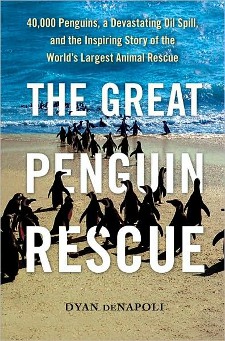Reviewed by Grant McCreary on April 2nd, 2011.
You may have seen the news recently of an oil spill in Tristan da Cunha threatening the endangered Northern Rockhopper Penguin. And I’m sure you heard of a little spill in the Gulf of Mexico not too long ago. But are you aware of an oil spill in South Africa a decade ago that threatened to wipe out an entire penguin species? Not to worry if you aren’t, I wasn’t either until I read The Great Penguin Rescue.
On June 23, 2000, the iron-ore carrier MV Treasure sank off the coast of Cape Town, South Africa. Oil from the ship escaped and contaminated the water around the primary breeding ground of the endangered African Penguin. It was, unfortunately, the breeding season for these birds. The penguins came into contact with the oil as they foraged for fish to feed their chicks. Even a small amount of oil on their feathers is essentially a death sentence, as it eliminates the waterproofing quality of the feathers, rendering the bird susceptible to the frigid waters. As wildlife rehabilitators watched the first oiled penguins walk out of the water onto their breeding islands, they had no idea that the largest wildlife rehabilitation project in history was about to be launched.
The author, who worked with penguins at the New England Aquarium at the time, was among a group of international penguin experts who rushed to South Africa to help. As deNapoli arrived at a warehouse hastily converted into a rehabilitation center, she was greeted by the unforgettable sight, and smell, of 16,000 oiled penguins.
In all, nearly 19,000 oiled penguins were rescued. Let that sink in for a moment. These birds ate five tons of fish a day. A rescue effort on this scale was unprecedented. Even after reading deNapoli’s evocative description of the scene, I still can’t fathom it. But unbelievably, 90% of these oiled birds would be successfully rehabilitated and returned to the wild.
In The Great Penguin Rescue, deNapoli ably describes the circumstances of the oil spill, the massive rescue effort, and the aftermath. In addition, she provides background on herself, penguins in general, and African Penguins specifically. The information on penguins, such as their physiology and unique adaptations, is especially welcome. It helps the reader understand the unique challenges involved in rescuing these birds, as well as provides a respite from the intensity of the rescue.
And it was intense. Indeed, “gut-wrenching” would not be overstating the effect of the narrative on me. But ultimately, this is an uplifting story. An incredible percentage of the penguins were saved, a number equal to half of the species’ entire population today. A further ray of hope came from an unlikely source. After reading about the horrors perpetrated on these animals by people, you may understandably have a healthy dose of misanthropy. But it was also people who saved them. This rescue would not have been possible without “the human miracle” of 12,500 volunteers that stepped up to help out. Reading about these thousands of people from Cape Town and all over the world that “had come together, and were working beyond the point of exhaustion, in horrendous conditions, to save the oiled penguins” was inspiring.
The writing in The Great Penguin Rescue is lively, though it goes a bit overboard at times (“the dark entryway loomed like a huge yawning mouth waiting to swallow us whole”). And it can be a little repetitive. But overall, the author does the story justice and keeps the reader’s interest throughout.
Recommendation
One volunteer from this rehabilitation effort, on seeing some of the rescued birds years later, said: “How often in your life do you get the chance to say you did something right – that you did something that made a real difference? And this made a difference, because these penguins were here.” The Great Penguin Rescue is a powerful story, one that needs to be heard. Not just to find out what occurred in South Africa eleven years ago, but so that we know, even though tragedies like this will keep occurring, there is hope.
However, as deNapoli points out, penguins today are in trouble. You can find up-to-date information on how you can help on the author’s Facebook page. But honestly, one of the best ways to help penguins is to buy this book (the author is donating a significant portion of the proceeds to penguin conservation organizations, and you can find an extensive list of such groups and ways to help in the book). And then share its message with someone else.
Disclosure: I get a small commission for purchases made through links in this post.
Disclosure: The item reviewed here was a complementary review copy provided by the publisher. But the opinion expressed here is my own, it has not been influenced in any way.





Comment